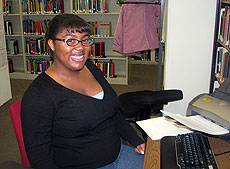On TARGET: Camilla Brewer

TARGET program intern Camilla Brewer helps maintain Business Services Section Web sites.
Editor's note: This is the first Q&A in a series on TARGET program students. Tonisha Taylor, a TARGET student working in the Office of Communication, conducted the interviews. A program overview article and article on the program's influence will appear in upcoming issues of Fermilab Today.
Camilla Brewer is a junior at Oak Park River Forest High School, participating in TARGET, a program that aims to expose high school students from underrepresented minority groups to physics and engineering. Camilla has spent her summer working with Jean Reising in the Business Services Section.
Q. What do you do at Fermilab?
A. My job is to repair, improve and create Web sites. If they have any site problems, I help fix them. Right now, I am working on a site that will identify people in a 1969 personnel photo.
Q. What is special about the 1969 personnel photo?
A. The year 1969 represents Fermilab's first staff. It is really cool to look up and see how different people were, and how the laboratory's goal of diversity has transcended time. People can log onto the site, click someone's picture and see who they were and what they did here at Fermilab.
Q. What do you like best about Fermilab?
A. The diversity here is awesome. I can just walk down the hall and hear about 18 different languages.
Q. What is your favorite science subject?
A. I like chemistry because I can see it, and it is very real to me.
Q. What do you think of when you hear the word Fermilab?
A. Before I got this job, my friend, Kerstin, told me to run around the accelerator. My physics teacher, Mr. Martinek, said it would be funny and called it the world's fastest 'Camilla Accelerator.'
Q. If you could make one discovery what would it be?
A. I have ideas about a lot of crazy inventions. Though if I had to choose one, I would create a phone that you could travel through. You could call Tokyo and instantly be right there.
Q. Wait, so you would be pulled through some sort of portal?
A. Yes, but I have not thought about it to that stage yet.
|